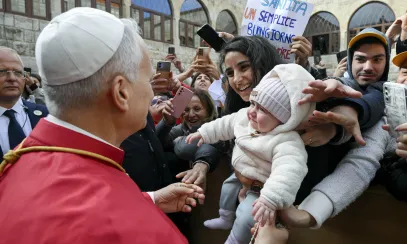
The Sistine Chapel Was Consecrated to Our Lady of the Assumption
5 Things to Know
5 Things to Know
CNA | On August 15, 1483, Pope Sixtus IV consecrated the Sistine Chapel to Our Lady of the Assumption. As we just celebrated the Feast of the Assumption of Mary, let’s take a closer look at this historic chapel.
One of the most popular tourist attractions in Vatican City, it is known for its magnificently frescoed ceilings, but it also serves an important function as the place where the cardinals meet to elect a new pope. Here are five things to know:
1. Where did the chapel get its name?
The chapel derives its name from the man who consecrated it: Pope Sixtus IV, who served as the Roman Pontiff from 1471 to 1484. He commissioned the restoration of the Cappella Magna, the chapel that stood where the Sistine Chapel stands today.
2. Who painted the frescoes?
The artist most famously connected with the Sistine Chapel is Michelangelo di Lodovico Buonarroti Simoni. However, it wasn’t until several years after a team of artists began work on the chapel, that Pope Julius II commissioned work from Michelangelo.
Between 1481 and 1482, four artists, Pietro Perugino, Sandro Botticelli, Domenico Ghirlandaio and Cosimo Rosselli, worked on the chapel's frescoes. These artists were assisted by their shops in painting the walls with false drapes, the Stories of Moses and Christ, as well as portraits of the popes.
Michelangelo painted the chapel ceiling and the lunettes on the upper part of the walls. Perhaps the most famous fresco in the chapel is his “Creation of Adam,” which portrays God in the form of a man, surrounded by angels and wrapped in a mantle, reaching towards Adam, while Adam reaches back up to God.
3. Michelangelo was telling a story
The “Creation of Adam,” although a focal point of the ceiling, is part of nine frescoes depicting different stories from the book of Genesis. The stories are separated into groups of three.
4. Pope John Paul II, the Sistine Chapel, and Theology of the Body
Walking into the Sistine Chapel, one might be surprised to see the many nude figures in the frescoes. During Mass in the Sistine Chapel on April 8, 1994, Pope John Paul II called the chapel a “sanctuary of the theology of the human body.”
The late pope and now-saint said in his homily: “It seems that Michelangelo, in his own way, allowed himself to be guided by the evocative words of the Book of Genesis which, as regards the creation of the human being, male and female, reveals: ‘The man and his wife were both naked, yet they felt no shame.’”
“The Sistine Chapel is precisely —if one may say so — the sanctuary of the theology of the human body,” he added. “In witnessing to the beauty of man created by God as male and female, it also expresses in a certain way, the hope of a world transfigured, the world inaugurated by the Risen Christ, and even before by Christ on Mount Tabor.”
5. One can take a virtual tour of the Sistine Chapel.
It's possible to visit the Sistine Chapel without leaving the house. The website for the Vatican Museums, allows one to virtually stroll through the chapel and zoom in on the details of each fresco.
The experience is not quite the same as being physically present, but visitors can take their time examining the frescoes without the usual crowds.
Bonus fact:
There is a spray-painted replica of the Sistine Chapel in the United States. Located in Waterloo, Iowa, at 622 Commercial street, Cappella Magna can be rented out for functions.
“Welcome to Capella Magna, Iowa's newly imagined premiere destination venue!” the organization’s description says. “Experience the only replica of the Sistine Chapel in the world. Host your corporate event, office party, wedding, or anniversary in the splendor and elegance of Michelangelo's masterpiece reimagined by Waterloo's own, Paco Rosic.”
The description says the venue seats 68 people in the main hall and 50 people in another area of the venue. Photos can be seen on the venue's Facebook page.



